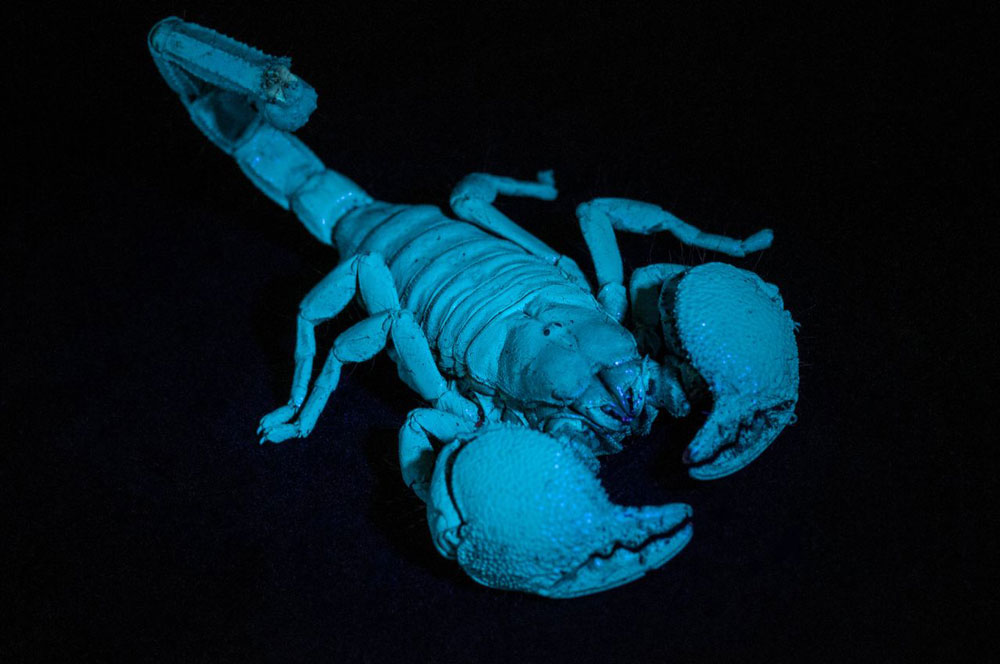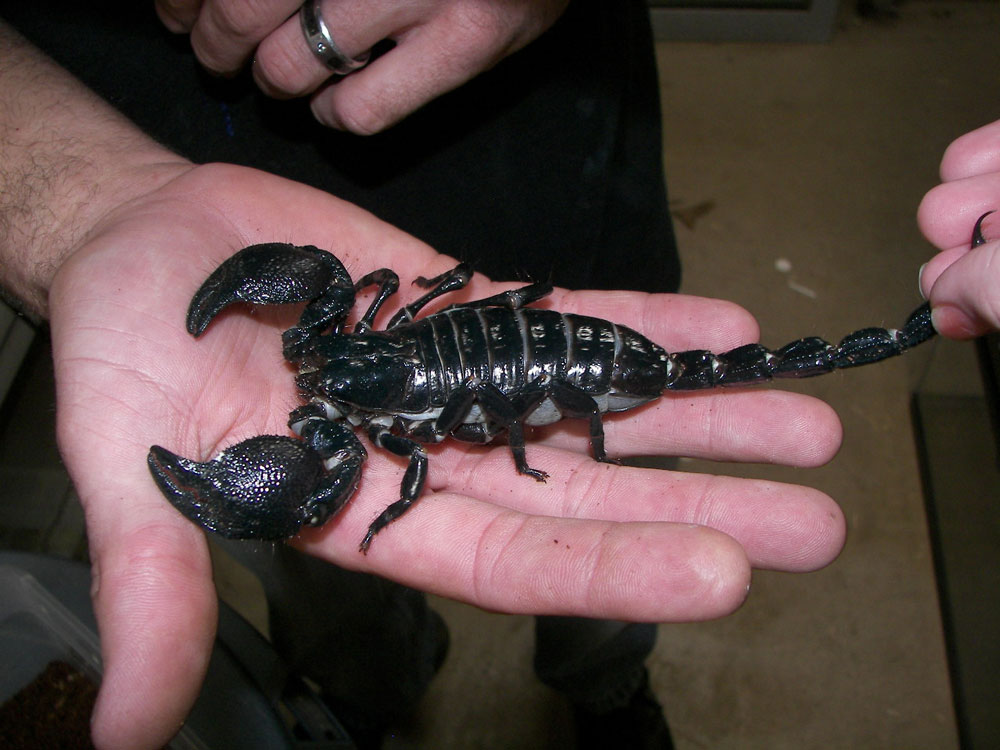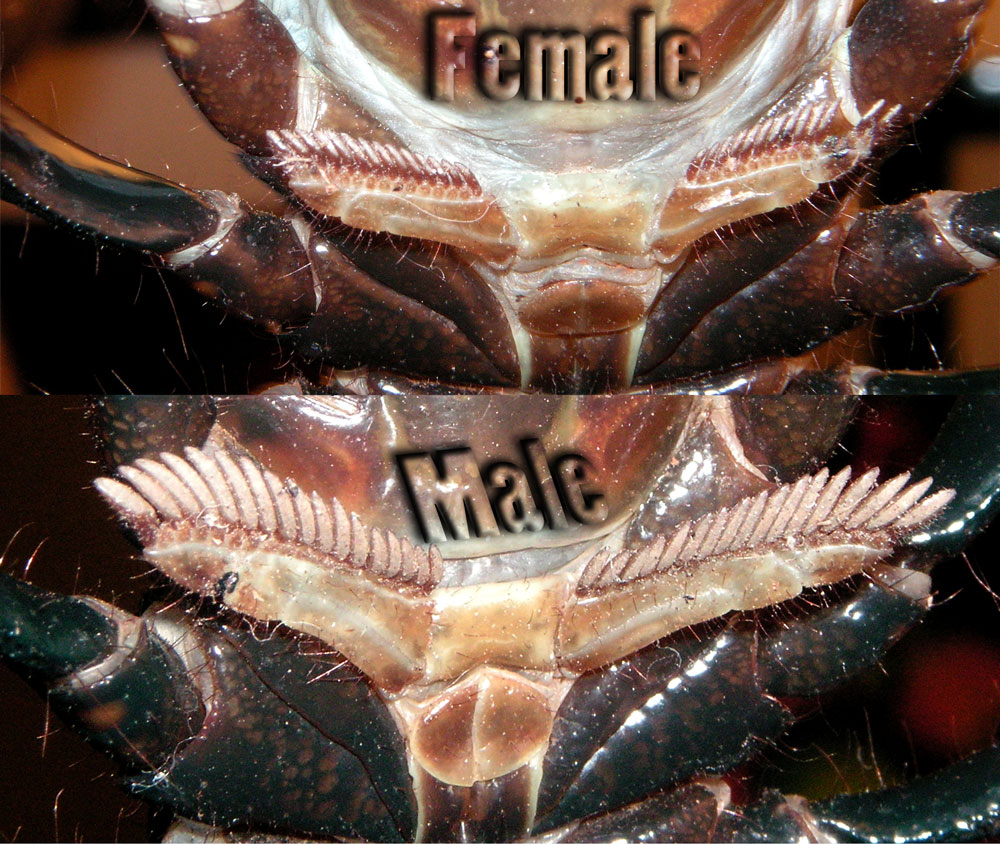Scientific Name
Pandinus imperator
Description
The Emperor Scorpion is one of the largest scorpion species in the world, with adult emperor scorpions averaging about 7.9 inches (20cms in length) and weighing approximately 30g (about 1 oz).
Its full body color is black, but like most scorpion species, this scorpion glows pastel green or blue when exposed to ultraviolet light.

The scorpion features some whitish membranes which connect its various body segments. In females, these membranes tend to expand during pregnancy.
The emperor scorpion is characterized by large-sized pinchers, 4 pairs of legs, and a long receptacle which contains venom glands and is also tipped by a curved, very sharp stinger.
Right behind their 4th pair of legs is a comb-like structure referred to as Pectines. The scorpion uses pectines to determine the texture of the ground. The pectines are significantly larger in male emperor scorpions than females.
Like all scorpion species, the emperor scorpion uses their sensory hairs to quickly detect both air and ground vibrations.
Because of their calm, docile nature, the emperor scorpion happens to be one of the most popular pet scorpions. It’s quite a popular pet species in the pet trade.
Another reason is that their venom is pretty much similar to that of bees. This means it’s not as dangerous and won’t therefore cause any serious harm to humans. However, the sting itself can cause some pain and will even draw quite some blood. Some people with severe allergic reactions to the venom may however develop serious complications. In such instances, immediate medical attention may be required.
The Emperor Scorpions are a common sight in most movies and television shows as they are somewhat safe for humans to interact with, not to mention their docile nature makes them easy to handle.
Food
Their diet mainly consists of insects such as termites and other terrestrial invertebrates (without backbones). However, these scorpions will occasionally feed on larger vertebrates (with backbones) such as lizards and rodents.
Habitat
The emperor scorpion dwells in the African rainforest. However, it can also be found in the savanna. Its habitats in the African Continent include Burkina Faso, Guinea, Togo, Benin, Gambia, Senegal, Sierra Leone, Nigeria, Côte d ‘Ivoire, Ghana, Guinea-Bissau, Mali, Liberia, and Cameroon
Predators
The emperor scorpion’s most common predators include large spiders, centipedes, lizards, bats, birds, and small mammals.
However, its worst predator is mankind. Thanks to the thriving pet trade that commonly targets this special scorpion species, their number has been greatly reducing, thus threatening their existence. Because of this, the emperor scorpion species has now been listed by CITES II (Convention on International Trade in Endangered Species of Wild Fauna and Flora) as an endangered species.

Social Structure
These scorpions are generally social compared to other species. They commonly live in small family groups mainly consisting of a mother and her offspring.
The emperor scorpion basically burrows into the soil and is often found under rocks, forest debris, logs, and other hidden areas. They are nocturnal hunters and use their sensory hairs to detect their prey. While hunting smaller prey, these scorpions rarely sting, Instead, they prefer grasping them with their strong claws and tearing them apart.
Birth and Offsprings
When mating, the male emperor scorpion grasps the female scorpion’s pincers where they both engage in an elaborate dance. The male will find the perfect spot on the ground to deposit his sperm and then position the female over it. Once in position, the female scorpion scoops up the sperms and place them inside her genitalia opening.

Like all scorpion species, the emperor scorpion gives live birth to their young ones. Gestation period is usually between 8 to 18 months depending on factors like food availability and temperature. Between 10 to 35 baby scorpions are born.
They are often vulnerable and unable to fend for themselves. For at least 7 months, baby scorpions are fed and cared for by the mother.
An emperor scorpion can live for around 6 to 8 years.
Senses
Emperor scorpions generally have a good sense of touch and hearing. However, their eyesight is very poor. They mainly depend on their sensory hairs to detect ground and air vibrations.

Lydia King is a huge animal lover and has always been fascinated with learning about the animal kingdom. She enjoys writing about anything animal related from scientific information about rare species to animal references in pop culture.












